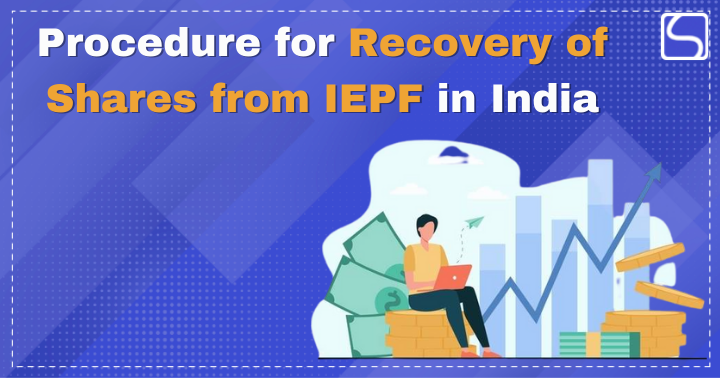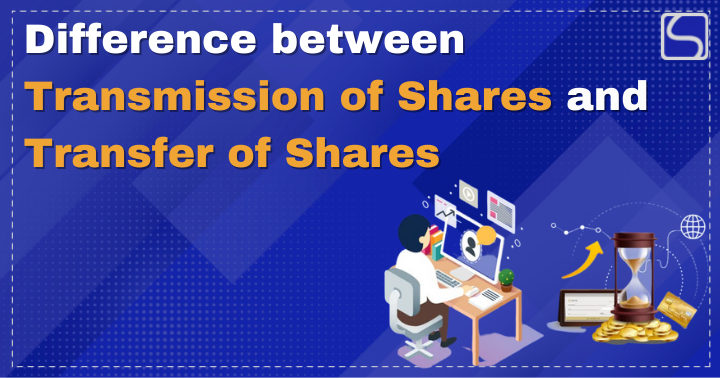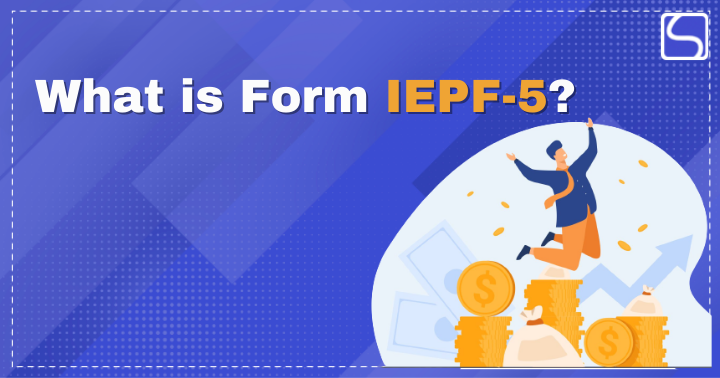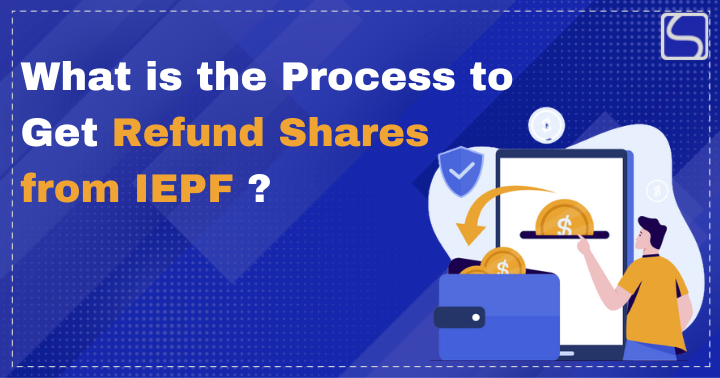Procedure for Recovery of Shares from IEPF in India

Snehita Shukla | Updated: Dec 03, 2022 | Category: Recovery of Shares
The shareholders may submit claims for the unpaid shares from the IEPF or Investor Education and Protection Fund. Anyone who had their due shares or dividends transferred to the IEPF can claim and recover those shares by adhering to a specific Procedure for Recovery of Shares from IEPF.
Table of Contents
Overview of the IEPF
The Indian government’s Ministry of Corporate Affairs established the Investor Education and Protection Fund on September 7, 2016. The laws of Section 125, Subsections (5), (6), and (7) of the Companies Act 2013 were used to create the IEPF regulations. The “Investor Education and Protection Fund” is discussed in Section 125, and the subsections therein discuss the rules and laws that are made in support of the companies or investors related to the IEPF. The IEPF was established to safeguard the interests of Investors who have stock market investments with unpaid dividends. The claim may be redeemed by adhering to the Procedure for Recovery of Shares from IEPF. Suppose no one claims the dividends on a share for seven consecutive years. In that case, the dividends are transferred to the IEPF minus any bonus shares for those seven years. The shareholders are always advised to make prompt dividend claims and to keep timely tabs on their finances.
The responsibility for managing the IEPF and returning unclaimed dividends, deposits, or debentures to investors falls on the Investor Education and Protection Fund authority. The Authority also monitors investor education efforts and works to safeguard their interests in the Market.
Inclusions of the IEPF
The Investor Education and Protection Fund is a fund that the Central Government establishes under Section 125 of the Companies Act of 2013. The IEPF is credited with the following:
- Amount awarded as grants by the government.
- contributions made to the IEPF by the state, businesses, or other institutions
- The sum that was transferred to the fund from the Unpaid Dividend Account
- The amount of the Central Government’s general revenue account
- The amount maintained under Section 205 C of the Companies Act of 1956’s Investor Education and Protection Fund
- Interest or other income received from Fund investments
- the sum of money received under the section
Removal of physical shares from circulation
Dematerialization is the process of converting physical holdings into digital Form. Since the physical transfer of shares is prohibited by SEBI, this dematerialization allows for the transfer of shares.
Who Has the Right to Recover Shares from the IEPF Authority?
You are qualified to receive a refund from the Investor Education & Protection Fund if you are a shareholder with shares that have been transferred to the IEPF but have not been claimed. Applying to the IEPF Authority will start the process. A claimant can only submit one claim per Company during a fiscal year by Rule. Before claiming the IEPF, claimants must follow all necessary legal requirements. Before approving the claim, the Company should also issue an entitlement letter.
Documents necessary for reclaiming shares from IEPF
You are qualified to receive a refund from the Investor Education & Protection Fund if you are a shareholder with shares that have been transferred to the IEPF but have not been claimed. Applying to the IEPF Authority will start the process. A claimant can only submit one claim per Company during a fiscal year by Rule. Before claiming the IEPF, claimants must follow all necessary legal requirements. Before approving the claim, the Company should also issue an entitlement letter.
The following documents must be submitted to start the Procedure for the Recovery of Shares from IEPF:
- Form of claim signed by the claimant and, in the case of joint holders, by all of the joint holders.
- A copy of the acknowledgement with the claimant’s proper attestation and the SRN number.
- With the claimant’s signature, an indemnity bond
- Advance Receipt with a Stamp
- Original certificate for a refund of bonds, debentures, or deposits that have matured
- Aadhar cards for both the claimant & if there are joint holders, each joint holder’s Aadhar cards.
- Card PAN.
- Client Master List that the claimant has properly attested.
- Certificate of Shares
- Evidence of Eligibility
- Returned Check
- Passport, along with OCI and PIO cards for foreign nationals and NRIs.
- A death certificate for the Joint Holder is necessary if he has passed away.
- Additional records, if any.
The Nodal Officer or Registrar is required to submit a verification report to the IEPF Authority.
Form IEPF 5 Requirements for Recovering Shares from IEPF
This IEPF 5 Form is submitted by the claimant to claim the shares. There can be only one claim per year & if the Form is rejected for listed reasons, the claimant must wait until the following year. The following information must be on Form IEPF 5:
- Information about the claimant
- company information, along with the CIN number
- Information on the shares that must be claimed
- The total dividend amount that must be claimed
- A list of the annual deposits and securities.
- An Aadhaar number and passport are required if the claimant is an NRI.
- Aadhar number-linked bank account information is used to refund the claim amount.
Details on Procedure for Recovery of Shares from IEPF
Investor Education Protection Funds (IEPF) exist solely to safeguard the interests of investors. However, once transferred to the IEPF, shareholders need help to claim their shares or dividends. To recover shares from the IEPF, a specific Procedure for Recovery of Shares from IEPF and related laws must be followed.
Investors whose shares, unclaimed dividends, matured debentures/deposits/ application money to be refunded & interest accrued on the same and sale proceeds of fractional shares, etc., have been transferred to IEPF may apply under subsection (3) of Section 125 of the Companies Act 2013 from the appropriate Authority to claim their shares under the procedure outlined in subsection (6) of Section 124.
Suppose the claimant is a registered shareholder’s legal heir, nominee, or successor. In that case, the Company must complete the transmission procedure and issue the claimant with an entitlement letter before the claimant can submit an IEPF claim to the Authority.
Form IEPF 5 is the IEPF’s recommendation for submitting a claim to recover shares. However, to avoid any objections, the Company or RTA must first give their necessary approval before filing this Form IEPF 5.
Steps to take if the IEPF recovers shares
Following is the Procedure for Recovery of Shares from IEPF:
- The First Procedure for Recovery of Shares from IEPF is that before claiming any of the Company’s shares, an investor requesting recovery of shares must finish their transmission procedure with the Company. They must submit an Application to the Ministry of Corporate Affairs in the given IEPF Form 5[1] with all the necessary information.
- The claimant then sends the same Form and all necessary documents to the Company’s Nodal Officer or Registrar. It is delivered in a package labelled “Claim for a refund from IEPF authority.[1]“
- Within 15 days, the Company must produce a verified report and send it, in a format recommended by the Authority, to the Authority.
- The Authority & the Drawing and Disbursement Officer properly verify the claimant’s eligibility. Then they submit a bill to the Pay and Accounts Officer for payment under the rules.
- Authority issues a sanction order for a refund along with the competent Authority’s approval.
- If the claimant has physical share certificates, duplicate certificates are cancelled, and shares are transferred to the claimant. Alternatively, shares may be credited to the claimant’s Demat account.
- Once the Company has provided the verification report, the refund is processed within 60 days.
Nodal Officers are the Company’s directors, chief financial officers, or company secretaries. A company may designate a Deputy Nodal Officer to assist the named Nodal Officer in verifying claims and coordinating with the Investor Education and Protection Fund Authority regarding the recovery of shares from IEPF. All of the Deputy Nodal Officer’s actions are held accountable to the Nodal Officer. Additionally, if the Company does not appoint a Nodal Officer, then each director of that Company is deemed to be a Nodal Officer and is held accountable for all failures in the same manner as a Nodal Officer.
Conclusion
An application is submitted in the required Form, Form IEPF 5, as a Procedure for the Recovery of Shares from IEPF. The Ministry of Corporate Affairs has released the 2017 Investor Education and Protection Fund Rules to recover such shares. According to Section 125 of the 2013 Companies Act, this Rule was created. Additionally, under this Rule, any dividend that is unpaid/ unclaimed for more than seven years in a row following the date of declaration is transferred to the Investor Education & Protection Fund (IEPF). However, one must finish the Company’s transmission process before applying for the recovery of such shares. The Nodal Officer of the Company verifies the claim after it is submitted in the designated Form, and following successful verification, it sends a verified report to the IEPF Authority. The Authority then issues a receipt as evidence of transfer and a sanction letter for a refund in the claimant’s favour. The claimant is then given ownership of the shares. It is completed within 60 days of the Company submitting its verification report to the IEPF Authority.
Read our Article:Difference between Transmission of Shares and Transfer of Shares














